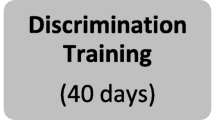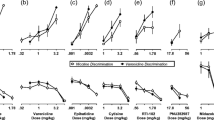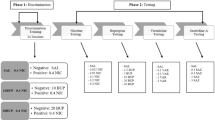Abstract
Rats were trained to discriminate nicotine from saline in a two-bar operant conditioning procedure with food reinforcement. There was partial generalization to the nicotine analogues anabasine and cytisine in rats trained to discriminate either 0.2 or 0.4 mg/kg nicotine from saline. However, generalization was complete in rats trained to discriminate 0.1 mg/kg nicotine and, in a novel procedure, any one of three doses of nicotine (0.1, 0.2, or 0.4 mg/kg). There was no generalization to the muscarinic-cholinergic agonist oxotremorine (0.0025–0.04 mg/kg). Additional experiments were carried to further characterize the response of rats trained with nicotine (0.1 mg/kg). These animals failed to generalize to compounds from a range of pharmacological classes (i.e., apomorphine, cocaine, chlordiazepoxide, picrotoxin, and quipazine), but there was partial generalization to amphetamine. Mecamylamine (0.5 mg/kg) but not hexamethonium (5.0 mg/kg) blocked the discrimination of nicotine and the generalization to cytisine. Anabasine (1.0–4.0 mg/kg) did not block the response to nicotine. The results support the view that the nicotine cue is mediated mainly through central cholinergic mechanisms. The dose of nicotine used for training has a very significant influence on the characteristics of the cue and 0.1 mg/kg of nicotine may be more suitable than 0.4 mg/kg as a training dose in future work.
Similar content being viewed by others
References
Abood LG, Lowy K, Tometsko A, Booth H (1978) Electrophysiological, behavioral, and chemical evidence for a non cholinergic, stereospecific site for nicotine in rat brain. J Neurosci Res 3:327–333
Barlow RB, McLeod LJ (1969) Some studies on cytisine and its methylated derivatives. Br J Pharmacol 35:161–174
Chance WT, Murfin D, Krynock GM, Rosecrans JA (1977) A description of the nicotine stimulus and tests of its generalization to amphetamine. Psychopharmacology 55:19–26
Clark MSG, Rand MJ, Vanov S (1965) Comparison of pharmacological activity of nicotine and related alkaloids occurring in cigarette smoke. Arch Int Pharmacodyn 156:363–379
Colpaert FC, Janssen PAJ (1982) OR discrimination: a new drug discrimination method. Eur J Pharmacol 78:141–144
Colpaert FC, Kuyps JJMD, Niemegeers CJE, Janssen PAJ (1976) Discriminative stimulus properties of a lowdl-amphetamine dose. Arch Int Pharaacodyn 223:34–42
Colpaert FC, Niemegeers CJE, Janssen PAJ (1980) Factors regulating drug cue sensitivity: the effect of training dose in fentanyl-saline discrimination. Neuropharmacology 19:705–713
Garcha HS, Giardini V, Pratt JA, Stolerman IP (1983) Anabasine and cytisine: nicotine-like behavioural effects in a drug-discrimination procedure. Br J Pharmacol 79:272P
Giorguieff MF, Le Floc'h ML, Glowinski J, Besson MJ (1977) Involvement of cholinergic presynaptic receptors of nicotinic and muscarinic types in the control of the spontaneous release of dopamine from striatal dopaminergic terminals in the rat. J Pharmacol Exp Ther 200:535–544
Herling S, Shannon HE (1982) Ro 15-1788 antagonizes the discriminative stimulus effects of diazepam in rats but not similar effects of pentobarbital. Life Sci 31:2105–2112
Holtzman SG (1982) Discriminative stimulus properties of opioids in the rat and squirrel monkey. In: Colpaert FC, Slangen JL (eds) Drug discrimination: applications in CNS pharmacology. Elsevier, Amsterdam, pp 17–36
Marks MJ, Collins AC (1982) Characterization of nicotine binding in mouse brain and comparison with the binding of bungarotoxin and quinuclidinyl benzilate. Mol Pharmacol 22:554–564
Meltzer LT, Rosecrans JA, Aceto MD, Harris LS (1980) Discriminative stimulus properties of the optical isomers of nicotine. Psychopharmacology 68:283–286
Pratt JA, Stolerman IP, Garcha HS, Giardini V, Feyerabend C (1983) Discriminative stimulus properties of nicotine: further evidence for mediation at a cholinergic receptor. Psychopharmacology 81:54–60
Romano C, Goldstein A (1980) Stereospecific nicotine receptors on rat brain membranes. Science 210:647–650
Romano C, Goldstein A, Jewell NP (1981) Characterization of the receptor mediating the nicotine discriminative stimulus. Psychopharmacology 74:310–315
Rosecrans JA, Chance WT (1977) Cholinergic and non-cholinergic aspects of the discriminative stimulus properties of nicotine. In: Lal H (ed): Discriminative stimulus properties of drugs. Plenum, New York, pp 155–185
Russell MAH, Jarvis M, Iyer R, Feyerabend C (1980) Relation of nicotine yield of cigarettes to blood nicotine concentrations in smokers. Br Med J 280:972–976
Shannon HE, Holtzman SG (1979) Morphine training dose: a determinant of stimulus generalization to narcotic antagonists in the rat. Psychopharmacology 61:239–244
Sloan JW, Martin WR, Todd GD (1983) Multiple nicotine binding sites rat brain P2 fraction. Psychopharmacology Bull 19:402–408
Stolerman IP, D'Mello GD (1981) Role of training conditions in discrimination of central nervous system stimulants by rats. Psychopharmacology 73:295–303
Stolerman IP, Pratt JA (1983) Discriminative and aversive properties of nicotine. Neuroscience Lett Suppl 14:S359
Stolerman IP, Pratt JA, Garcha HS, Giardini V, Kumar R (1983) Nicotine cue in rats analysed with drugs acting on cholinergic and 5-hydroxytryptamine mechanisms. Neuropharmacology 22:1029–1037
Winer BJ (1971) Statistical principles in experimental design. 2 edn. McGraw-Hill, New York
Author information
Authors and Affiliations
Rights and permissions
About this article
Cite this article
Stolerman, I.P., Garcha, H.S., Pratt, J.A. et al. Role of training dose in discrimination of nicotine and related compounds by rats. Psychopharmacology 84, 413–419 (1984). https://doi.org/10.1007/BF00555223
Received:
Accepted:
Issue Date:
DOI: https://doi.org/10.1007/BF00555223




